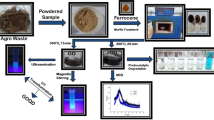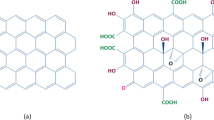Abstract
Agricultural waste, which negatively impacts human health and the environment, can be used as a beneficial precursor for the synthesis of graphene oxide. In the current study, Green technology carbonaceous material derived from Agrowaste can be potentially converted into value-added reduced graphene oxide for effective application of Wound dressing. Setaria italica bio-waste was through improved Hummers method graphene oxide was synthesized. Reduced graphene oxide (rGO) was formed by reducing the synthesized graphene oxide with a phytoextract of Prosopis juliflora. UV–visible spectroscopy was used to characterize the synthesized materials, with the maximal absorbance range for graphene oxide being 232 nm and 262 nm for reduced graphene oxide, showing good reduction using the phytoextract. The XRD revealed 2θ peaks for graphene oxide and reduced graphene oxide at 15.21° and 22.96°, respectively showing the amorphous nature due to large and strong peaks. Peaks in the 3500 cm−1, 2920 cm−1, 1620 cm−1, and 1053 cm−1 FTIR range exhibited the functional groups –OH stretching, symmetric and antisymmetric –CH2 stretching, C=C stretching, and C–O stretching. The intensities of the oxygen-carrying functional groups have been found to be reduced in reduced graphene oxide as a result of the reduction process. Curled single-layer sheets for graphene oxide and wrinkled aggregated structures for reduced graphene oxide are shown by morphological investigation. Anti-oxidant, anti-bacterial, anti-diabetic, anti-inflammatory, and biocompatibility tests yielded positive findings, with less hemolysis of 0.2% and anti-coagulation capabilities up to the fifteenth minute, proved with a statistical approach. Based on the results obtained, the formulated bio-gel has good biocompatibility, non-toxic, and efficient at even low concentrations. Our study is unique because an rGO bio-gel with improved therapeutic characteristics can be proposed as a feasible formulation for future as a wound dressing Supportive material.
Graphical abstract




















Similar content being viewed by others
Availability of data and materials
Data will be available upon reasonable request.
References
Abergel, D. S. L., Apalkov, V., Berashevich, J., Ziegler, K., & Chakraborty, T. (2010). Properties of graphene: A theoretical perspective. Advances in Physics, 59(4), 261–482.
Aiyalu, R., Govindarjan, A., & Ramasamy, A. (2016). Formulation and evaluation of topical herbal gel for the treatment of arthritis in animal model. Brazilian Journal of Pharmaceutical Sciences, 52, 493–507.
Alam, S. N., Sharma, N., & Kumar, L. (2017). Synthesis of graphene oxide (Graphene Oxide) by modified hummers method and its thermal reduction to obtain reduced graphene oxide (reduced Graphene Oxide). Graphene, 6(1), 1–18.
Allen, M. J., Tung, V. C., & Kaner, R. B. (2010). Honeycomb carbon: A review of graphene. Chemical Reviews, 110(1), 132–145.
Andonovic, B., Temkov, M., Ademi, A., Petrovski, A., Grozdanov, A., & Paunovic, P. (2014). Laue functions model vs Scherrer equation in determination of graphene layers number on the ground of XRD data. Journal of Chemical Technology and Metallurgy, 49, 545–550.
Aslam, M., Kalyar, M. A., & Raza, Z. A. (2016). Synthesis and structural characterization of separate graphene oxide and reduced graphene oxide nanosheets. Materials Research Express, 3(10), 105036.
Avouris, P., & Dimitrakopoulos, C. (2012). Graphene: Synthesis and applications. In Materials Today, 15, 86–97.
Balouiri, M., Sadiki, M., & Ibnsouda, S. K. (2016). Methods for in vitro evaluating antimicrobial activity: A review. In Journal of Pharmaceutical Analysis, 6, 71–79.
Bera, M., Gupta, P., Chandravati, G. P., & Maji, P. K. (2018). Facile one-pot synthesis of graphene oxide by sonication assisted mechanochemical approach and its surface chemistry. Journal of Nanoscience and Nanotechnology, 18(2), 902–912.
Burits, M., & Bucar, F. (2000). Antioxidant activity of Nigella sativa essential oil. Phytotherapy Research, 14(5), 323–328.
Çiplak, Z., Yildiz, N., & Cąlimli, A. (2015). Investigation of graphene/Ag nanocomposites synthesis parameters for two different synthesis methods. Fullerenes Nanotubes and Carbon Nanostructures, 23(4), 361–370.
Dantas, M. G. B., Reis, S. A. G. B., Damasceno, C. M. D., Rolim, L. A., Rolim-Neto, P. J., Carvalho, F. O., et al. (2016). Development and evaluation of stability of a gel formulation containing the monoterpene borneol. The Scientific World Journal, 2016, 7394685.
Deng, J., You, Y., Sahajwalla, V., & Joshi, R. K. (2016). Transforming waste into carbon-based nanomaterials. In Carbon, 96, 105–115.
Deng, X., Li, W., Wang, Y., & Ding, G. (2020). Recognition and separation of enantiomers based on functionalized magnetic nanomaterials. TrAC Trends in Analytical Chemistry, 124, 115804.
Dey, P., Chatterjee, P., Chandra, S., & Bhattacharya, S. (2011). Comparative in vitro evaluation of anti-inflammatory effects of aerial parts and roots from Mikania scandens. J Adv Pharm Educ Res, 1, 271–277.
Emiru, T. F., & Ayele, D. W. (2017). Controlled synthesis, characterization and reduction of graphene oxide: A convenient method for large scale production. Egyptian Journal of Basic and Applied Sciences, 4(1), 74–79.
Extraction and Fractionation of Insoluble Fibers from Foxtail Millet (Setariaitalica (L.) P. Beauv). (2011). https://www.researchgate.net/publication/269858980_Extraction_and_Fractionation_of_Insoluble_Fibers_from_Foxtail_Millet_Setaria_italica_L_P_Beauv
Geim, A. K., & Novoselov, K. S. (2007). The rise of graphene. Nature Materials, 6(3), 183–191.
Haghighi, B., & Tabrizi, M. A. (2013). Green synthesis of reduced graphene oxide nanosheets using rose water and a survey on their characteristics and applications. In RSC Advances, 3, 13365–13371.
Hashem, M. A., Payel, S., Hasan, M., Momen, M. A., & Sahen, M. S. (2021). Green preservation of goatskin to deplete chloride from tannery wastewater. HighTech and Innovation Journal, 2(2), 99–107.
Hui, L., Piao, J. G., Auletta, J., Hu, K., Zhu, Y., & Meyer, T. (2014). Availability of the basal planes of graphene oxide determines whether it is antibacterial. ACS Applied Materials and Interfaces, 6(15), 13183–13190.
Jamadar, M. J., & Shaikh, R. H. (2017). Preparation and evaluation of herbal gel formulation. J. Pharm. Educ. Res, 1(2), 201–224.
Katsnelson, M. I. (2007). Graphene: Carbon in two dimensions. Materials Today, 10, 20–27.
Khadayeir, A. A., Wannas, A. H., & Yousif, F. H. (2022). Effect of applying cold plasma on structural, antibacterial and self cleaning properties of α-Fe2O3 (HEMATITE) thin film. Emerging Science Journal, 6(1), 75–85.
Khan, M., Al-Marri, A. H., Khan, M., Mohri, N., Adil, S. F., Al-Warthan, A., Siddiqui, M. R. H., Alkhathlan, H. Z., Berger, R., Tremel, W., & Tahir, M. N. (2014). Pulicariaglutinosa plant extract: A green and eco-friendly reducing agent for the preparation of highly reduced graphene oxide. RSC Advances, 4(46), 24119–24125.
Kim, F., Cote, L. J., & Huang, J. (2010). Graphene oxide: Surface activity and two-dimensional assembly. Advanced Materials, 22(17), 1954–1958.
Krutyakov, Y. A., Kudrinskiy, A. A., Olenin, A. Y., & Lisichkin, G. V. (2008). Synthesis and properties of silver nanoparticles: Advances and prospects. Russian Chemical Reviews, 77(3), 233.
Lin, F., Li, C., & Chen, Z. (2018). Bacteria-derived carbon dots inhibit biofilm formation of Escherichia coli without affecting cell growth. Frontiers in Microbiology, 9, 259.
Liu, S., Zeng, T. H., Hofmann, M., Burcombe, E., Wei, J., & Jiang, R. (2011). Antibacterial activity of graphite, graphite oxide, graphene oxide, and reduced graphene oxide: Membrane and oxidative stress. ACS Nano, 5, 6971–6980.
Marcano, D. C., Kosynkin, D. V., Berlin, J. M., Sinitskii, A., Sun, Z., Slesarev, A., Alemany, L. B., Lu, W., & Tour, J. M. (2010). Improved synthesis of graphene oxide. ACS Nano, 4(8), 4806–4814.
Mousavi, S. H., Kavianpour, M. R., & Alcaraz, J. L. G. (2023). The impacts of dumping sites on the marine environment: A system dynamics approach. Applied Water Science, 13(5), 109.
Nasiri, M., Nasiri, H., Nasiri, S., Bitarafan, M., & Fazelabdolabadi, B. (2021). The global equity market reactions of the oil & gas midstream and marine shipping industries to COVID-19: An entropy analysis. HighTech and Innovation Journal, 2(4), 346–358.
Pan, N., Guan, D., & He, T. (2013). Removal of Th4+ ions from aqueous solutions by graphene oxide. Journal of Radioanalytical and Nuclear Chemistry, 298(3), 1999–2008.
Perera, D. S. M., De Silva, R. C. L., Nayanajith, L. D. C., Colombage, H. C. D. P., Suresh, T. S., Abeysekera, W. P. K. M., & Kottegoda, I. R. M. (2021). Anti-inflammatory and antioxidant properties of Coffea arabica/reduced graphene oxide nanocomposite prepared by green synthesis. Material Science Research India, 18, 305–317.
Pitchaipillai, R., & Ponniah, T. (2016). In vitro antidiabetic activity of ethanolic leaf extract of Bruguiera cylindrica L.–glucose uptake by yeast cells method. International Biological and Biomedical Journal, 2(4), 171–175.
Preethy, K. R., & Chamundeeswari, M. (2022). Optimization of reduced graphene oxide production using central composite design from Pennisetum glaucum for biomedical applications. Biotechnology and Applied Biochemistry., 70, 773–789.
Ramesh, S., Vinitha, U. G., Anthony, S. P., & Muthuraman, M. S. (2020). Pods of Acacia nilotica mediated synthesis of copper oxide nanoparticles and it’s in vitro biological applications. Materials Today: Proceedings, 47, 751–756.
Ren, W., & Cheng, H. M. (2014). The global growth of graphene. In Nature Nanotechnology, 9, 726–730.
Roy, B. (2022). Production technology of foxtail millet (All India co-ordinated project on small millet). https://www.researchgate.net/publication/359558527Production_technology_of_foxtail_millet_All_India_coordinated_project_on_smallmillet
Sahira Banu, K., & Cathrine, L. (2015). General techniques involved in phytochemical analysis. International Journal of Advanced Research in Chemical Science (IJARCS), 2(4), 25–32.
Shahriary, L., & Athawale, A. (2014). Graphene oxide synthesized by using modified hummers approach. Nternational Journal of Renewable Energy and Environmental Engineering, 02, 58–63.
Sharma, B. K., Saha, A., Rahaman, L., Bhattacharjee, S., & Tribedi, P. (2015). Silver inhibits the biofilm formation of Pseudomonas aeruginosa. Advances in Microbiology, 05, 677–685.
Sharma, N., & Niranjan, K. (2018). Foxtail millet: Properties, processing, health benefits, and uses. In Food Reviews International, 34, 329–363.
Slowing, I. I., Wu, C. W., Vivero-Escoto, J. L., & Lin, V. S. Y. (2009). Mesoporous silica nanoparticles for reducing hemolytic activity towards mammalian red blood cells. Small (weinheim an Der Bergstrasse, Germany), 5(1), 57–62.
Somanathan, T., Prasad, K., & Ostrikov, K. K. (2015). Graphene oxide synthesis from agro waste. Nanomaterials, 5, 826–834.
Tamilselvi, R., Ramesh, M., Lekshmi, G. S., Bazaka, O., Levchenko, I., & Bazaka, K. (2020). Graphene oxide – based supercapacitors from agricultural wastes: a step to mass production of highly efficient electrodes for electrical transportation systems. Renewable Energy, 151, 731–739.
Ukande, M. D., Shaikh, S., Murthy, K., & Shete, R. (2019). Review on Pharmacological potentials of Prosopis juliflora. Journal of Drug Delivery and Therapeutics, 9(4–s), 755–760.
Wang, Y., Zhang, P., Fang Liu, C., Zhan, L., Fang Li, Y., & Huang, C. Z. (2012). Green and easy synthesis of biocompatible graphene for use as an anticoagulant. RSC Advances, 2(6), 2322–2328.
Wei, X. Q., Hao, L. Y., Shao, X. R., Zhang, Q., Jia, X. Q., & Zhang, Z. R. (2015). Insight into the interaction of graphene oxide with serum proteins and the impact of the degree of reduction and concentration. ACS Applied Material Interfaces, 7, 13367–13374.
Xu, Y., Bai, H., Lu, G., Li, C., & Shi, G. (2008). Flexible graphene films via the filtration of water-soluble noncovalent functionalized graphene sheets. Journal of the American Chemical Society, 130, 5856–5857.
Yadav, N., & Lochab, B. (2019). A comparative study of graphene oxide: Hummers, intermediate and improved method. FlatChem, 13, 40–49.
Ye, J., Wu, Y. C., Xu, K., Ni, K., Shu, N., Taberna, P. L., Zhu, Y., & Simon, P. (2019). Charge Storage Mechanisms of Single-Layer Graphene in Ionic Liquid. Journal of the American Chemical Society, 141(42), 16559–16563.
Za’im, N. N. M., Yusop, H. M., & Ismail, W. N. W. (2021). Synthesis of water-repellent coating for polyester fabric. Emerging Science Journal, 5(5), 747–754.
Zhu, Y., Murali, S., Cai, W., Li, X., Suk, J. W., Potts, J. R., & Ruoff, R. S. (2010). Graphene and graphene oxide: Synthesis, properties, and applications. Advanced Materials, 22(35), 3906–3924.
Funding
No funds, grants, or other support was received.
Author information
Authors and Affiliations
Corresponding author
Ethics declarations
Competing interests
The authors declare that they have no competing interests.
Ethical approval
Not applicable.
Additional information
Publisher's Note
Springer Nature remains neutral with regard to jurisdictional claims in published maps and institutional affiliations.
Rights and permissions
Springer Nature or its licensor (e.g. a society or other partner) holds exclusive rights to this article under a publishing agreement with the author(s) or other rightsholder(s); author self-archiving of the accepted manuscript version of this article is solely governed by the terms of such publishing agreement and applicable law.
About this article
Cite this article
Preethy, K.R., Ammu Chandhini, A. & Chamundeeswari, M. Bio-waste valorization to formulate an eco-friendly reduced graphene oxide based bio-gel for clinical applications. Environ Dev Sustain (2024). https://doi.org/10.1007/s10668-024-04700-8
Received:
Accepted:
Published:
DOI: https://doi.org/10.1007/s10668-024-04700-8




